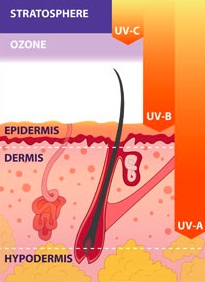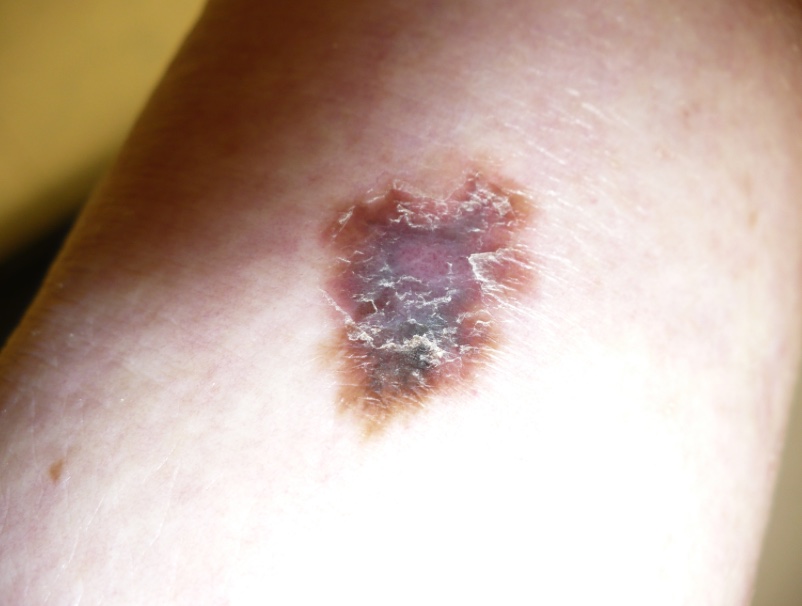Vitamin D and skin health
How easy is it to optimize on sunlight exposure, creating vitamin D and skin health benefits, without over-doing the exposure and depriving your skin of protection?
The fact is, we need sunlight but we also need protection from it!

Like food and water, too little of either will kill you, and too much will make you sick.
But one thing I do know is that whenever I get a little sunshine on a daily basis, my skin actually feels better.
Various Vitamin D skin benefits have been seen to include:
- acne disappearing after vitamin D supplementation
- more radiant, fresh, younger looking skin
Sunlight provides us with the most effective source of making Vitamin D naturally. Made in our bodies through a series of processes that start when our skin is exposed to UVB rays, it is sort of like the photosynthesis process of plants.
So Vitamin D and skin health and wellbeing go hand in hand in this process that provides all mammals with what is actually more accurately described as a hormone, not a vitamin.
Vitamin D and skin benefits
Although closely related because of how vitamin d is produced, there are also specific vitamin d benefits for the skin.
One of the main benefits is in the treatment of psoriasis, as Vitamin D has been used for decades around the globe to treat this specific skin problem.
Vitamin d plays a role in the metabolism of skin cells and their growth. This has been illustrated through its effectiveness in treating skin with itching and flaking issues which are common symptoms of a psoriasis skin problem.
 Skin layers and UV light
Skin layers and UV lightTransdermal treatments have tended to put some people off as they believe this method to be ineffective.
However, many studies have found that the vitamin D creams sold over the counter are mostly ineffective as they do not make use of the active form of Vitamin D.
Usually, this active vitamin d form is only available in prescription creams or supplements. Also, as several weeks of treatment are required to see some relief from the psoriasis symptoms, people rather choose the supplement route.
It is far preferable to use these creams in preference to the more typical steroid cream treatment, as the side effects are minimal.
Light treatment involving UVB ray emissions is another effective treatment for psoriasis due to the obvious vitamin d creation. This is a fabulously natural route, although pure sunshine may be considered for an alternative.
There are numerous vitamin D health benefits for your skin but it is an unfortunate fact that vitamins such as C or E get the limelight and vitamin D is overlooked, despite its proven capability in dealing with specific skin care problems such as psoriasis.
Vitamin d is a fat-soluble vitamin as well as a powerful antioxidant and anti-carcinogen.
It exists in several forms and calciferol is the most active form of the vitamin. Once produced or ingested, the liver and kidneys act on the vitamin d to convert it into this active form that the body can use.
With these qualities. vitamin d plays an important role in preventing the premature aging of your skin as well as alleviating any damage to the skin structure.
Vitamin D and skin cancer
 Vitamin d helps with skin cancer
Vitamin d helps with skin cancerThe sun's ultraviolet (UV) radiation is a major cause of skin cancer, as well as the best source of vitamin D.
It is vitally important to take a balanced UV exposure approach to boost vitamin D levels while minimizing the risk of skin cancer with relevant sun protection measures.
Too much sun exposure will lead to skin cancer as well as premature skin aging. As a general rule, five to ten minutes of midday summer sun exposure on unprotected skin such as the arms, legs and back will provide enough UVB exposure to produce the required amount of vitamin d for the body.
Much of the evidence gathered by vitamin d studies, indicates that the synthesis of vitamin D and skin exposure to the sun's UVB rays, works in a feedback loop that prevents any toxicity happening.
However, because of uncertainty about the cancer risk from sunlight, no recommendations have actually been issued by health institutions such as the Institute of Medicine in the USA, for the amount of sun exposure required to meet vitamin D requirements.
Some vitamin d can be acquired through eating the right food, but this is not believed to be sufficient unless you are living in the extreme northern latitudes and eat a huge amount of oily fish or polar bear liver in your diet!
Vitamin D and skin type
 Vitamin D and your skin type
Vitamin D and your skin typeResearchers from Boston University School of Medicine (BUSM) have found that previtamin D3 production varies depending on several factors including skin type and weather conditions.
Your skin type plays a big part in the variations on the time required in the sunlight for adequate vitamin D creation. eg. Dark skinned individuals need greater amounts of sun exposure in order for their skin to produce the same amount of vitamin d as for lighter skinned individuals.
There are other factors too that all play a role in reducing the amount of ultra violet light exposure and vitamin d production by the skin:
- proximity to the equator
- time of day
- time of year
- cloud cover
- pollution
So, dark skin can be a health hazard if:
- you live far from the equator
- get little sun exposure
- consume too little vitamin D
That describes many African Americans and helps explain why studies find that average African-American children as well as adults have much lower blood levels of vitamin D than do average white Americans.
Depending on your skin type, you are only required to have exposure to the sun's direct rays, ie. around midday, for about 10 - 20 minutes to be able to create the recommended daily amount of 5000 IU's of Vitamin D. This requires important self management of exposure to the sun as it is vital that you never allow time for your skin to burn due to the potential for skin cancer and premature aging.
Beyond this time management, the following sunscreen qualities will allow you to get the full benefits of Vitamin D, while being protected from any harmful effects of the sun:
- Free of toxic chemical ingredients
- Provides high UVA protection
- Provides enough UVB protection to prevent burning but allow Vitamin D production
- Feed your skin with added ingredients such as anti-oxidants, to combat sun-based or environmental toxin damage
And finally, if unsure in any way of your vitamin d levels, it would pay to go and have a blood test. It's quick and simple.
Vitamin D and skin referrences:
Effects of vitamin D and Skin's Physiology examined




New! Comments
Have your say... please leave me a comment in the box below.